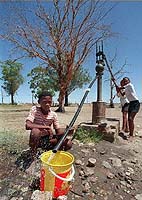| . |  |
. |
 Los Angeles - November 19, 1999 - New research by NASA Goddard and University of California, Los Angeles scientists to be published in the Nov. 19th issue of the journal Science, shows that the devastating drought that plagued North Africa for decades may be a natural phenomenon-fueled by the land's naturally-changing vegetation cover.
Los Angeles - November 19, 1999 - New research by NASA Goddard and University of California, Los Angeles scientists to be published in the Nov. 19th issue of the journal Science, shows that the devastating drought that plagued North Africa for decades may be a natural phenomenon-fueled by the land's naturally-changing vegetation cover.Scientists have been trying to understand what caused the paralyzing drought that began in the 1970s, ravaging North Africa and causing the Sahara desert to advance to the south. Some studies suggested that by using the land for farming and livestock grazing, humans were responsible for bringing about the drought and keeping the land from recovering. Caption: Picture dated 13 February 1992 shows South African children filling a bucket of water the village's well. An international conference water management due to open in Paris 19 March aims to replace the rhetoric of previous talks with practical measures to better channel the planet's dwindling fresh-water resources. UN figures show 1.5 billion people around the world have little or no access to drinking water, a statistic which prompted French President Jacques Chirac to propose the UNESCO-backed conference grouping 84 countries. Photo Copyright AFP Researchers have found that previous drought conditions in Africa grasslands cause following years to remain drier, over-riding meteorological conditions which otherwise would have caused more rain to fall. The approach scientists took was to put natural vegetation in a (computer) climate model and make it fully interactive with land surface processes and atmospheric processes," said William Lau, a Goddard Space Flight Center (Greenbelt, Md.) atmospheric scientist. Lau, along with UCLA atmospheric scientists Ning Zeng and David Neelin, found that the addition of vegetation to climate computer models proved to be the missing link in what was driving the drought. "The Sahel has gone through a well-known drought in the 70s and 80s, and it is a huge economic concern for the countries in the Sahel region like Nigeria, Niger and Mali," said Zeng. "One school of thought has blamed the drought on the lack of rainfall caused by changing temperatures of the ocean surface." Other studies, said Zeng, claim the drought is more man-made. In trying to decipher the true cause, the team used a computer climate model to see how much of the drought could be accounted for by the cooler sea surface temperatures that suppress summer monsoons and bring less rain to the Sahel region. Lau said the model showed that changing sea surface temperatures couldn't account for much of the drought at all. "If you look at the sea surface temperature as a drought forcing phenomenon over 50 years, you see a very weak drought, not enough to explain the observed variance and the long term severity of the drought," he said. To find what else may be causing the decades-long dry spell, the scientists added another factor -- soil moisture -- to the climate model. They found that as the soil dried out, the air lost humidity, making the chance of rain decrease even more. But still, said Lau, it was only enough to account for a drought half as severe as what actually happened in the Sahel. Finally, the team added natural vegetation to the model and found that the natural vegetation interacts significantly with climate, and in the case of the Sahel drought, caused enhanced drying. "The way it works is when it gets dryer due to changes in sea surface temperature, less vegetation grows. And less vegetation leads to higher surface albedo," said Zeng. A higher surface albedo -- or a greater amount of reflected solar radiation -- leads to a drier, cooler climate. The cooling effect weakens the monsoon circulation, and less moisture comes in from the south and the west, he said. Also, since plants transpire by losing water through their leaves, less vegetation decreases humidity. The loss of a direct moisture supply means less rainfall, which causes weaker circulation, dampening the monsoon season. "This is the first time a realistic global model is able to show the interactive natural vegetation on a time scale of decades," said Zeng. Lau said that the new model including natural vegetation changes is a much better reflection of what the Sahel region actually experienced. And it suggests that without the addition of man-made landscape changes, the climate system is fully capable of generating this devastating type of drought.
TERRADAILY.COM
|
| |||||||||
| The content herein, unless otherwise known to be public domain, are Copyright 1995-2016 - Space Media Network. All websites are published in Australia and are solely subject to Australian law and governed by Fair Use principals for news reporting and research purposes. AFP, UPI and IANS news wire stories are copyright Agence France-Presse, United Press International and Indo-Asia News Service. ESA news reports are copyright European Space Agency. All NASA sourced material is public domain. Additional copyrights may apply in whole or part to other bona fide parties. Advertising does not imply endorsement, agreement or approval of any opinions, statements or information provided by Space Media Network on any Web page published or hosted by Space Media Network. Privacy Statement All images and articles appearing on Space Media Network have been edited or digitally altered in some way. Any requests to remove copyright material will be acted upon in a timely and appropriate manner. Any attempt to extort money from Space Media Network will be ignored and reported to Australian Law Enforcement Agencies as a potential case of financial fraud involving the use of a telephonic carriage device or postal service. |